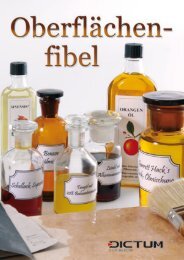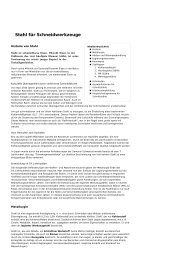Download the Natural Finishing Manual in PDF
Download the Natural Finishing Manual in PDF
Download the Natural Finishing Manual in PDF
Create successful ePaper yourself
Turn your PDF publications into a flip-book with our unique Google optimized e-Paper software.
Marple-surface<br />
Left: untreated (f<strong>in</strong>ished by plane). Right: varnished with Propolis-L<strong>in</strong>seed Oil<br />
varnish<br />
Propolis-L<strong>in</strong>seed Oil Varnish<br />
Ratio by weight of l<strong>in</strong>seed oil / beeswax / propolis = 8 / 2,5 / 4.<br />
This recipe yields a high quality, pleasant-smell<strong>in</strong>g and<br />
ecologically friendly varnish for wooden objects which come<br />
<strong>in</strong> frequent contact with sk<strong>in</strong>, e.g. children’s toys, bathroom<br />
and sauna furniture, kitchen utensils, wooden spoons, etc.<br />
We recommend us<strong>in</strong>g a l<strong>in</strong>seed oil which is free of chemicals,<br />
such as our L<strong>in</strong>olja oil (No. 705275). To make <strong>the</strong> varnish,<br />
first warm <strong>the</strong> l<strong>in</strong>seed oil to ca. 60° - 70° C and dissolve<br />
<strong>the</strong> propolis <strong>in</strong> <strong>the</strong> oil. Next, filter <strong>the</strong> solution and mix <strong>the</strong><br />
beeswax <strong>in</strong>to <strong>the</strong> warm solution. To improve <strong>the</strong> varnish’s<br />
resistance to water, 10 - 50% Ch<strong>in</strong>ese tung oil (Lignea, No.<br />
705286) may be used. The hardness of <strong>the</strong> varnish can also<br />
be <strong>in</strong>creased by replac<strong>in</strong>g some of <strong>the</strong> beeswax with <strong>the</strong><br />
harder Carnauba wax (No. 810009).<br />
Russian Varnish<br />
Ratio by weight of l<strong>in</strong>seed oil / beeswax / propolis = 4 / 1 / 2.<br />
A variation of <strong>the</strong> varnish described above which displays a<br />
higher degree of hardness, primarily used for restor<strong>in</strong>g<br />
antiques or objects subject to heavy wear. Directions as<br />
above.<br />
Harden<strong>in</strong>g<br />
Addition of res<strong>in</strong>s such as mastic, sandarac or shellac will<br />
<strong>in</strong>crease <strong>the</strong> hardness of <strong>the</strong> varnish coat and make apply<strong>in</strong>g<br />
<strong>the</strong> varnish easier.<br />
De-Wax<strong>in</strong>g<br />
The wax dissolved <strong>in</strong> <strong>the</strong> propolis-alcohol solution can be<br />
removed if a f<strong>in</strong>ish with a higher degree of hardness is<br />
desired. Simply cool <strong>the</strong> solution until <strong>the</strong> wax solidifies<br />
at <strong>the</strong> surface are remove it from <strong>the</strong> solution.<br />
Harden<strong>in</strong>g<br />
Addition of res<strong>in</strong>s such as mastic, sandarac or shellac will<br />
<strong>in</strong>crease <strong>the</strong> hardness of <strong>the</strong> varnish coat and make apply<strong>in</strong>g<br />
<strong>the</strong> varnish easier.<br />
25
















